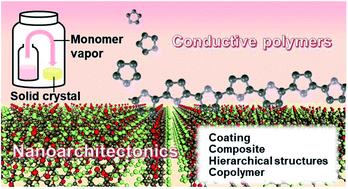Nanoarchitectonics for conductive polymers using solid and vapor phases
Abstract
Conductive polymers have been extensively studied as functional organic materials due to their broad range of applications. Conductive polymers, such as polypyrrole, polythiophene, and their derivatives, are typically obtained as coatings and precipitates in the solution phase. Nanoarchitectonics for conductive polymers requires new methods including syntheses and morphology control. For example, nanoarchitectonics is achieved by liquid-phase syntheses with the assistance of templates, such as macromolecules and porous materials. This minireview summarizes the other new synthetic methods using the solid and vapor phases for nanoarchitectonics. In general, the monomers and related species are supplied from the solution phase. Our group has studied polymerization of heteroaromatic monomers using the solid and vapor phases. The surface and inside of solid crystals were used for the polymerization with the diffusion of the heteroaromatic monomer vapor. Our nanoarchitectonics affords to form homogeneous coatings, hierarchical structures, composites, and copolymers for energy-related applications. The concepts using solid and vapor phases can be applied to nanoarchitectonics for not only conductive polymers but also other polymers toward a variety of applications.

- This article is part of the themed collections: Design and function of materials nanoarchitectonics and Recent Review Articles


 Please wait while we load your content...
Please wait while we load your content...